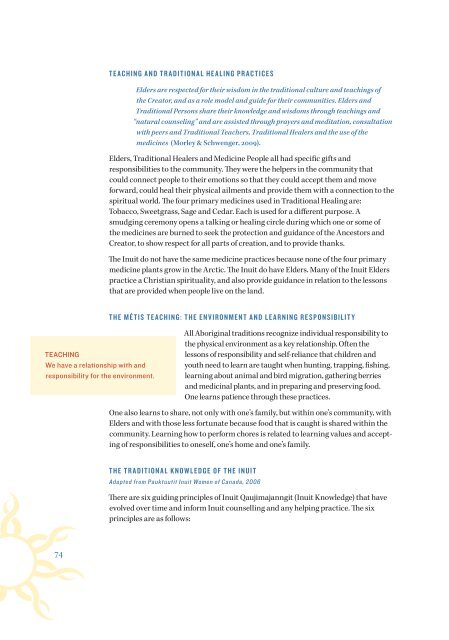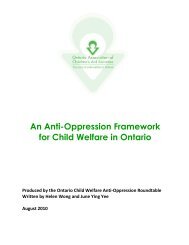English - Ontario Association of Children's Aid Societies
English - Ontario Association of Children's Aid Societies
English - Ontario Association of Children's Aid Societies
You also want an ePaper? Increase the reach of your titles
YUMPU automatically turns print PDFs into web optimized ePapers that Google loves.
TEACHING AND TRADITIONAL HEALING PRACTICES<br />
Elders are respected for their wisdom in the traditional culture and teachings <strong>of</strong><br />
the Creator, and as a role model and guide for their communities. Elders and<br />
Traditional Persons share their knowledge and wisdoms through teachings and<br />
“natural counseling” and are assisted through prayers and meditation, consultation<br />
with peers and Traditional Teachers, Traditional Healers and the use <strong>of</strong> the<br />
medicines (Morley & Schwenger, 2009).<br />
Elders, Traditional Healers and Medicine People all had specific gifts and<br />
responsibilities to the community. They were the helpers in the community that<br />
could connect people to their emotions so that they could accept them and move<br />
forward, could heal their physical ailments and provide them with a connection to the<br />
spiritual world. The four primary medicines used in Traditional Healing are:<br />
Tobacco, Sweetgrass, Sage and Cedar. Each is used for a different purpose. A<br />
smudging ceremony opens a talking or healing circle during which one or some <strong>of</strong><br />
the medicines are burned to seek the protection and guidance <strong>of</strong> the Ancestors and<br />
Creator, to show respect for all parts <strong>of</strong> creation, and to provide thanks.<br />
The Inuit do not have the same medicine practices because none <strong>of</strong> the four primary<br />
medicine plants grow in the Arctic. The Inuit do have Elders. Many <strong>of</strong> the Inuit Elders<br />
practice a Christian spirituality, and also provide guidance in relation to the lessons<br />
that are provided when people live on the land.<br />
THE MÉTIS TEACHING: THE ENVIRONMENT AND LEARNING RESPONSIBILITY<br />
TEACHING<br />
We have a relationship with and<br />
responsibility for the environment.<br />
All Aboriginal traditions recognize individual responsibility to<br />
the physical environment as a key relationship. Often the<br />
lessons <strong>of</strong> responsibility and self-reliance that children and<br />
youth need to learn are taught when hunting, trapping, fishing,<br />
learning about animal and bird migration, gathering berries<br />
and medicinal plants, and in preparing and preserving food.<br />
One learns patience through these practices.<br />
One also learns to share, not only with one’s family, but within one’s community, with<br />
Elders and with those less fortunate because food that is caught is shared within the<br />
community. Learning how to perform chores is related to learning values and accepting<br />
<strong>of</strong> responsibilities to oneself, one’s home and one’s family.<br />
THE TRADITIONAL KNOWLEDGE OF THE INUIT<br />
Adapted from Pauktuutit Inuit Women <strong>of</strong> Canada, 2006<br />
There are six guiding principles <strong>of</strong> Inuit Qaujimajanngit (Inuit Knowledge) that have<br />
evolved over time and inform Inuit counselling and any helping practice. The six<br />
principles are as follows:<br />
74

















